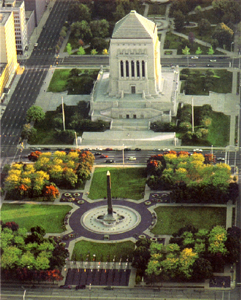Indiana World War Memorial Plaza Historic District
|
Indiana War Memorial Plaza
|
|

Aerial view of the plaza looking south
|
|
| Location | Bounded by St. Clair, Pennsylvania, Vermont, and Meridian Sts., Indianapolis, Indiana |
|---|---|
| Coordinates | 39°46′25″N 86°9′25″W / 39.77361°N 86.15694°WCoordinates: 39°46′25″N 86°9′25″W / 39.77361°N 86.15694°W |
| Built | 1924 |
| Architect | Walker & Weeks; Henry Hering |
| Architectural style | Beaux-Arts, Neoclassical |
| NRHP reference # | 89001404 |
| Significant dates | |
| Added to NRHP | September 25, 1989 |
| Boundary increase | December 23, 2016 |
| Designated NHLD | October 11, 1994 |
The Indiana World War Memorial Plaza is an urban feature located in Indianapolis, Indiana, United States, originally built to honor the veterans of World War I. The five-city-block plaza was conceived in 1919 as a location for the national headquarters of the American Legion and a memorial to the state's and nation's veterans. At the north end of the plaza is the American Legion Mall, which is the site of the administration buildings of the Legion, as well as a memorial cenotaph. South of that is the Veterans Memorial Plaza with its obelisk.
The centerpiece of the plaza is the Indiana World War Memorial, modeled after the Mausoleum of Halicarnassus. Within is a military museum, the Shrine Room, and an auditorium. At the south end is University Park, the oldest part of the plaza, filled with statues and a fountain. On October 11, 1994, the Indiana World War Memorial Plaza was designated a National Historic Landmark District. The list was enlarged (and renamed) in 2016, to include in its scope the Soldiers' and Sailors' Monument.
The origins of the Indiana World War Memorial Plaza lay in a 1919 attempt by the city of Indianapolis to lure the newly formed American Legion from its temporary headquarters in New York City. The American Legion, chartered by Congress in 1919 after World War I, is an organization of veterans that sponsors youth programs, promotes patriotism and national security, and provides commitment to Americans who have served in the armed forces. Three Indianapolis veterans wanted to attract the Legion to the city, which already had the Soldiers' and Sailors' Monument. At an American Legion national convention in Minneapolis during November 1919, cities sent representatives to lobby to become the new headquarters. Indianapolis drew support because of its central location within the United States and the city's shows of patriotism. Although Washington, D.C. received the most votes on the first ballot, Indianapolis gained a majority and won the second with 361 votes out of 684 cast.
...
Wikipedia



